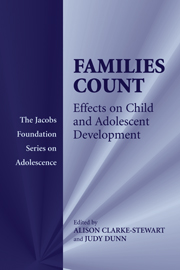Book contents
- Frontmatter
- Contents
- List of Contributors
- Introduction
- PART ONE RISK AND RESILIENCE
- PART TWO PEERS AND PARENTS
- PART THREE WORK AND FAMILY
- PART FOUR DISCORD AND DIVORCE
- PART FIVE NEW AND EXTENDED FAMILY FORMS
- PART SIX CONCLUSIONS AND COMMENTARIES
- 13 What Have We Learned: Proof That Families Matter, Policies for Families and Children, Prospects for Future Research
- 14 Research and Policy: Second Looks at Views of Development, Families, and Communities, and at Translations into Practice
- 15 Prognosis: Policy and Process
- Index
- References
15 - Prognosis: Policy and Process
Published online by Cambridge University Press: 05 June 2012
- Frontmatter
- Contents
- List of Contributors
- Introduction
- PART ONE RISK AND RESILIENCE
- PART TWO PEERS AND PARENTS
- PART THREE WORK AND FAMILY
- PART FOUR DISCORD AND DIVORCE
- PART FIVE NEW AND EXTENDED FAMILY FORMS
- PART SIX CONCLUSIONS AND COMMENTARIES
- 13 What Have We Learned: Proof That Families Matter, Policies for Families and Children, Prospects for Future Research
- 14 Research and Policy: Second Looks at Views of Development, Families, and Communities, and at Translations into Practice
- 15 Prognosis: Policy and Process
- Index
- References
Summary
To provide a commentary at the end of a volume with such exceptional contributions, a volume that will certainly be a landmark in the field, is a formidable assignment. Rather than commenting on the obvious elegance and excellence of the chapters, I shall try to comment on the volume as a whole from three perspectives – contributions to policy, to intervention, and to prevention.
Impact on Policy
The chapters have two goals, one aimed toward policy makers with the aim of guiding interventions and the other, the understanding of process to benefit clinicians. So far as policy is concerned, I suggest that these chapters may mark a high point, after which further work of this sort will bring decreasing returns in the form of policy changes. Longitudinal studies will continue to be essential for revealing sleeper and steeling effects, for consequential models, and for assessing resilience. New situations and new problems will arise, and there will be need for new studies in the future. But, given the nature of the variables used in these large-scale studies, the main conclusions are already laid out, and practically every study implies complexity.
All the chapters deal with an extremely complex network of inter-related mutual influences, and an important characteristic of the volume as a whole is that it recognizes complexity more clearly than much of the earlier work.
- Type
- Chapter
- Information
- Families CountEffects on Child and Adolescent Development, pp. 361 - 370Publisher: Cambridge University PressPrint publication year: 2006
References
- 3
- Cited by

